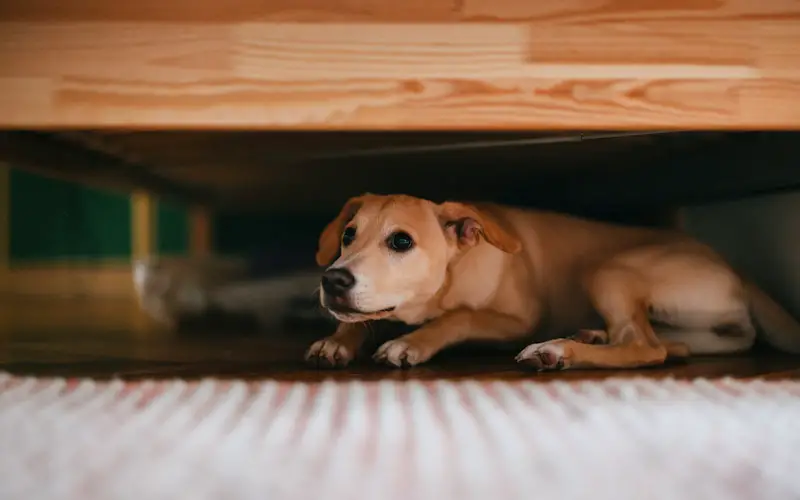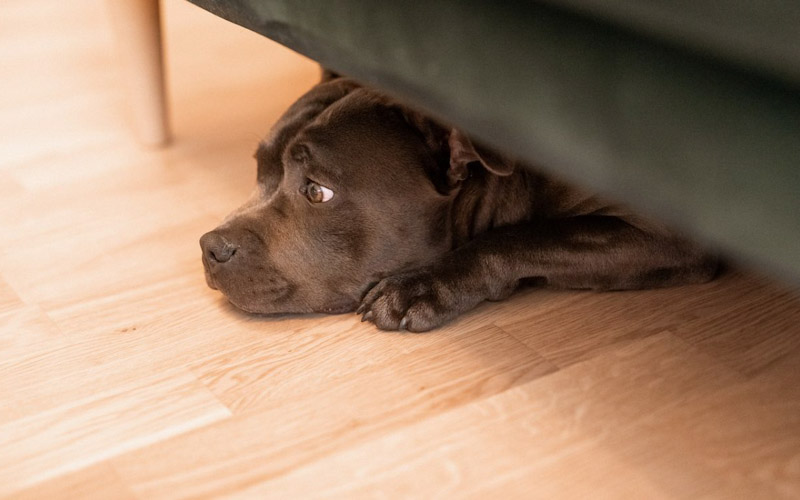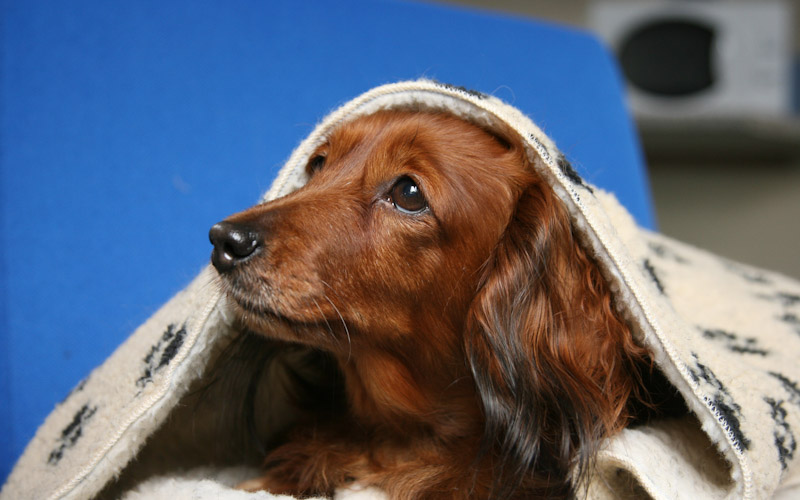Storms can be scary for anyone, but especially for dogs. Some dogs are naturally more prone to storm anxiety than others, depending on their breed, personality, and past experiences. Storm anxiety can cause dogs to act in ways that are unusual or even harmful to themselves or their surroundings.

In this article, we will discuss the signs that your dog may be scared of storms, the reasons why dogs may be afraid of storms, and how to help your dog cope with storm anxiety.
Physical Signs of Storm Anxiety in Dogs
Storm anxiety can cause dogs to exhibit various physical signs, such as:
– Trembling: Dogs may shake or shiver when they are scared of storms. This is a natural response to stress or fear, as it helps them regulate their body temperature and release tension.
– Panting: Dogs may pant excessively when they are scared of storms. This is a way of cooling down their body and coping with anxiety. However, panting can also indicate overheating, dehydration, or pain, so it is important to monitor your dog’s condition and provide them with water and shade if needed.
– Pacing: Dogs may pace back and forth or in circles when they are scared of storms. This is a sign of restlessness and nervousness, as they are trying to find a way to escape or avoid the storm.
– Hiding: Dogs may hide under the bed, in the closet, or in the bathroom when they are scared of storms. This is a way of seeking shelter and safety from the storm. Some dogs may also try to dig or burrow into the ground or furniture, which can cause damage to your property.
– Vocalizing: Dogs may bark, howl, whine, or growl when they are scared of storms. This is a way of expressing their fear or discomfort, or trying to communicate with you or other dogs. Some dogs may also be silent or mute, which can indicate extreme fear or shock.
– Destructive behavior: Dogs may chew, scratch, or bite objects or themselves when they are scared of storms. This is a way of releasing their frustration or anxiety, or trying to distract themselves from the storm. However, this can also cause injury to your dog or damage to your belongings.

Behavioral Signs of Storm Anxiety in Dogs
Storm anxiety can also cause dogs to exhibit various behavioral signs, such as:
– Clinging to their owners: Dogs may seek comfort and reassurance from their owners when they are scared of storms. They may follow you around, sit on your lap, or lean on you. This is a sign of attachment and trust, as they see you as their protector and leader.
– Avoiding eye contact: Dogs may avoid eye contact with you or other dogs when they are scared of storms. This is a sign of submission and respect, as they are trying to avoid confrontation or aggression. However, this can also indicate low self-esteem or depression, so it is important to provide your dog with positive reinforcement and affection.
– Irritability: Dogs may become irritable or aggressive when they are scared of storms. They may snap, bite, or bark at you or other dogs, or show their teeth or ears back. This is a sign of defensiveness and insecurity, as they are trying to protect themselves or their territory from the storm or perceived threats.
– Loss of appetite: Dogs may lose their appetite or refuse to eat or drink when they are scared of storms. This is a sign of stress or nausea, as they are feeling sick or uncomfortable from the storm. However, this can also lead to dehydration or malnutrition, so it is important to encourage your dog to eat or drink, or consult your vet if the problem persists.
Reasons Why Dogs May Be Afraid of Storms
There are many possible reasons why dogs may be afraid of storms, such as:
– Loud noises: Storms can produce loud noises, such as thunder, lightning, wind, or rain. These noises can startle or frighten dogs, as they are unfamiliar or unpredictable. Dogs have a more sensitive hearing than humans, so they can hear noises that we cannot, or hear them louder or clearer. Loud noises can also trigger negative associations or memories in dogs, such as fireworks, gunshots, or explosions.
– Flashing lights: Storms can produce flashing lights, such as lightning, power outages, or emergency vehicles. These lights can confuse or scare dogs, as they are sudden or unnatural. Dogs have a different vision than humans, so they can see lights that we cannot, or see them differently or more intensely. Flashing lights can also trigger negative associations or memories in dogs, such as cameras, flashlights, or lasers.
– Changes in barometric pressure: Storms can cause changes in barometric pressure, which is the measure of the weight of the air. These changes can affect the air pressure in your dog’s ears, which can cause discomfort or pain. Dogs can also sense these changes before humans can, which can make them anxious or uneasy.

How to Help Your Dog Cope with Storm Anxiety
Storm anxiety can be a serious problem for dogs, as it can affect their physical and mental health, as well as their relationship with you and other dogs. However, there are some ways to help your dog cope with storm anxiety, such as:
– Provide your dog with a safe place to hide: One of the best ways to help your dog cope with storm anxiety is to provide them with a safe place to hide, such as a crate, a bed, or a blanket. This can help your dog feel more secure and comfortable, as they can retreat to their own space and avoid the storm. You can also make the place more cozy and inviting by adding toys, treats, or your clothes, which can provide your dog with familiar smells and sounds.
– Play calming music or sounds: Another way to help your dog cope with storm anxiety is to play calming music or sounds, such as classical music, white noise, or nature sounds. This can help your dog relax and distract them from the storm, as they can focus on the soothing sounds instead of the scary ones. You can also talk to your dog in a calm and gentle voice, which can provide them with reassurance and comfort.
– Give your dog a calming supplement: Another way to help your dog cope with storm anxiety is to give them a calming supplement, such as a chew, a tablet, or a spray. These supplements can contain natural ingredients, such as chamomile, lavender, or melatonin, which can help your dog reduce their stress and anxiety levels. However, you should always consult your vet before giving your dog any supplement, as some may have side effects or interactions with other medications.
– Work with a professional trainer: Another way to help your dog cope with storm anxiety is to work with a professional trainer, who can help you teach your dog some coping skills and techniques, such as desensitization, counterconditioning, or relaxation. These skills and techniques can help your dog gradually overcome their fear of storms, by exposing them to the storm stimuli in a controlled and positive way. However, you should always work with a qualified and experienced trainer, who can tailor the training to your dog’s needs and personality.
Conclusion
Storm anxiety is a common and serious problem for dogs, as it can cause them to act in ways that are unusual or harmful to themselves or their surroundings. However, by recognizing the signs that your dog may be scared of storms, understanding the reasons why dogs may be afraid of storms, and helping your dog cope with storm anxiety, you can help your dog overcome their fear and enjoy a happier and healthier life.
If your dog’s storm anxiety is severe or affecting their quality of life, you should seek professional help from your vet or a trainer, who can provide you with more advice and support.
We hope you found this article helpful and informative. If you did, please share it with your friends and family, who may also have dogs that are scared of storms. Thank you for reading!
